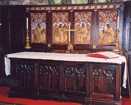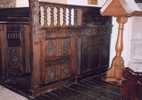For this church:    |
Oxton St Peter and St PaulFeatures and FittingsChancelAltar
Reredos4-panel polyptych with a scrolling leaf pattern on the top rail in red and gold. Each panel is decorated with applied gothic tracery over a painted wood relief of the four apostles, from left to right: John, Luke, Mathew and Mark, each with the appropriate attributes. At the base of the reredos is a gradine, and at each end a riddel bracket of wrought iron. It dates from 1927. ScreenA low screen with two bays to the north and south of the chancel. Each has a plain top rail and a transom decorated with scoop moulding over a wide freeze with lunette decoration and terminates in posts decorated with carved figures. To the north, there is a figure with a long pipe, and to the south a player with a bagpipe, both with coned finials. The central bays to either side have barley sugar twist spindles over the transom and a lower stage of four coffered panels, each decorated with a carved lozenge design. The outer bays have a narrow panel decorated with a vitruvian scroll above the transom, and a lower stage of a plain wide, coffered panel over three plain narrow, coffered panels, all standing on a plain bottom rail. (1927)
Oak panelling3 sections to left of altar. Coffered plain panels increasing in size from top to bottom, with chamfered sill and a casement moulded top rail. (1927)
|
| SURELY THE LORD IS IN THIS PLACE AND I KNOW IT NOT AND HE WAS AFRAID AND SAID HOW DREADFUL IS THIS PLACE. THIS IS NONE OTHER BUT THE HOUSE |
Panels of scalloped fleur de lys moulding. The stall backs are plain with grooved mountings. The carved top rail was removed from the top of the north choir stall to its present position in 1987.
The reredos, oak panelling, choir stalls and screen were erected in memory of Evelyn Kyrle Smith. The family coat of arms appears on the stall front on the north side together with the dedication:
| TENAX IN FIDE IN MEMORY OF EVELYN.KYRLE.SMITH WHO DIED 20 SEPT:1925 THESE CHOIR STALLS & SCREEN WERE ERECTED BY HIS WIDOW & DAUGHTER |
Aumbry
Two coffered wooden doors with brass handles set in north wall below the communion rail.
Communion rail
Laudian style. Oak. Turned balusters with a gouged and domed rail and a chamfered sill. At each end against the walls there is a flat post with a poppy head. C17.
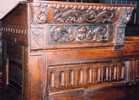 Reader’s
desk
Reader’s
desk
Desk type with flat top and sloping flap with butterfly hinges. Front decorated with egg and dart moulding over a panel with leaf decoration; a panel with a central child’s face with leaf decoration either side. The sides have guilloche moulding. A Gift of Mr Foster.
Coat of arms
Top. Red with gold cross keys, silver sword with gold
handle.
Left. Blue with a gold cross Henree and five gold martlets.
Right. Blue with Agnus Dei and gold banner of victory.
Shaft. Black with silver cross. Top right, a silver lily. Top left, not clear.
On the back a small plate inscribed:
| Presented to Rev.W.T.P.Wheeler from St John’s Church Colwick-in-the-Vale 1950 |
Nave
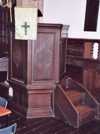 Pulpit
Pulpit
Possibly Jacobean. Much remodelled and repaired in the 1898-1900 restoration, “rendering it almost new”. The panels are decorated with cartouches carved by the Revd H Tibbs, (circa 1860). It has a six-sided drum with a door and a cornice with embattled decoration. The bottom rails of three of the panels have raised lettering:
| Blessed are they that have the word Oh God and keep it |
The stem is of six plain panels on a six-sided plinth and there is a stairway of three treads on the south side.
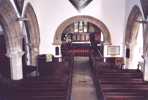 View of the nave (looking east) View of the nave (looking east)showing the seating here |
Seating Benches and Box Pews
Standing on a wooden plinth. The bench ends are plain with chamfered edges surmounted with simple poppy heads. The backs have plain panels. The oak box pews have two plain sunk panels with brass circular catches at the end and plain horizontal panelled backs. The top rail is plain.
Two Naval Ensigns
Brass shields below read:
| THIS ENSIGN WAS FLOWN BY H.M.S. TARANTULA COMMANDER HENRY SHERBROOKE D.S.O., R.N. DURING OPERATIONS IN MESOPOTAMIA IN 1917 RESULTING IN THE CAPTURE OF BAGHDAD AND THE EXPULSION OF THE TURKS AND GERMANS FROM THE COUNTRY |
| THIS ENSIGN WAS FLOWN BY H.M.S.ONSLOW CAPTAIN ROBERT ST. VINCENT SHERBROOKE, D.S.O., R.N. ALSO COMMANDING THE 17TH DESTROYER FLOTILLA DURING AN ACTION IN THE BARENTS SEA WHEN PROTECTING A CONVEY TO NORTH RUSSIA ON 31ST DECEMBER 1942 THE ENEMY FORCE CONSISTING OF THE GERMAN SHIPS DEUTSCHLAND, HIPPER AND SEVERAL DESTROYERS WERE SUCCESSFULLY DRIVEN OFF AND THE CONVOY REACHED HARBOUR SAFELY CAPTAIN SHERBROOKE AN IMMEDIATE AWARD OF THE VICTORIA CROSS |
Lectern
Oak. Double desk type with swivel top and gable ends decorated alternately with American bald eagle and Pennsylvania coat of arms. Baluster stem with cruciform base and plain sill. Made by Advent Hunston, Tideswell, Derby. It was given in 1964.
Carved dedication on one desk face:
| IN MEMORIAM RALPH H. LANE PH.D. 1907-1963 OF WASHINGTON D.C. A DIRECT DESCENDANT OF ROBERT SCOTHORN OF OXTON 1659-708 A DEDICATED TEACHER OF THOSE WHO TEACH “THE MEMORY OF THE JUST IS BLESSED” |
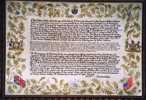 Framed
Manuscript
Framed
Manuscript
Illuminated and embroidered, recording the events of 14th October 1951 concerning Robert Scothorn. Exhibited at Lambeth Palace as a part of the Festival of Britain, 1951. Made by J.N.Dowse, Newark, 1951.
The text reads as follows:
On Sunday, October 14th in the year of the Festival of Britain the Memorial in the church to Robert Scothorn, born Oxton 1659, died Chester County Pennsylvania 1708 was unveiled by one of his descendants; Dr Ralph Lane of Washington, U.S.A. on behalf of many of his compatriots themselves also being Scothorn descendants; one of that number, Miss Florence LeClerq Eisele of Natchez, Mississippi, being, with Dr Lane, the leading inspirers of the researchers which preceded the decision to erect the Memorial. On the same day the State Flag of Pennsylvania, a gift to the church by the State Governor, His Excellency the Hon. John S. Fine, was unveiled by William H. Morris Esq., Embassy Attache for Cultural Affairs, himself a son of Pennsylvania, acting on behalf of His Excellency the United States Ambassador to the Court of St. James, the Rt Hon. Walter Gifford. This flag is to commemorate the strong links between Oxton and the State of Pennsylvania, in that four sons of Oxton, baptised in this church, emigrated to the new colony and assisted in its founding. Thomas Worth, and Samuel Bradshaw sailed in1682, almost certainly with William Penn; in 1683 Thomas Bradshaw followed and these were joined in the following year by Robert Scothorn.
Also on the historic day in 1951 referred to, the Memorial to the Prebends of Oxton was unveiled by Canon C. Leeper, M.A., Chancellor of Southwell Cathedral; the Tablet at the Chancel Arch commemorating the Restoration of the Church in that year was unveiled by the squire of Oxton (whose ancestors came here 400 years before) Rear Admiral R. St. V. Sherbrooke, V.C., D.S.O., R.N., then holding the Naval position of Flag-Officer, Germany and the diplomatic Office of British Naval member of the Allied Control Commission in Western Europe; the Oxton Church Historical Vellum, after its return from the 1951 Festival Exhibition of Ecclesiastical Art in Lambeth Palace was unveiled by Lord Charles Cavendish Bentinck, D.S.O. The Dedications were performed by the Lord Bishop of Southwell (Dr. F.R. Barry, D.S.O.) and these included the New Gate at the SW entrance to God’s Acre; new Staves of Office for the Churchwardens; the restoration work in and upon the Chancel, Nave and Tower; the old Font, identified, reassembled, and restored to the Baptistry after desecration during the Commonwealth Period and subsequent disuse.
The Thanksgiving and Dedication Service was conducted by the Bishop, assisted by the Vicar of this Parish, in the presence of those already named together with the High Sheriff of the County, Major E.H. Spalding, T.D., Miss D.R. Janson, J.P. representing the Lord High Chancellor of England, and members of the Society of Friends, Nottingham. The Church was filled with these and other notable visitors, with members of the community of this village, benefactors from this County and abroad and the faithful worshipping congregation of this Parish Church. The occasion was reported by the Midland Region of the British Broadcasting Corporation and the National Press in this country & America. Booklets of the Service and ceremonies were requested by many citizens of U.S.A., by the State Library of Pennsylvania, the Hall of the Historical Society, Philadelphia, and by the Library of the United States Congress. To ensure the perpetual remembrance of this day, the Lord Bishop assigned to it, by his Episcopal Mandate, the observance year by year of the Dedication of this Church, ten centuries ago, the original date being now unknown. This date October 14th, which is also the anniversary of the birthday of William Penn, therefore, is one worthy to be remembered in the long story of this ancient village and its richest and most treasured possession, the Parish Church, Mother of Christianity in this part of God’s Vineyard.
G.W.L. Darwin
J.F. Coton
Churchwardens
Located beneath the manuscript is a small brass plaque which reads:
| THIS HISTORICAL VELLUM WAS ACCEPTED FOR THE EXHIBITION OF ECCLESIASTICAL ART AT LAMBETH PALACE, LONDON. The official residence of the Archbishop of Canterbury IN CONNECTION WITH THE FESTIVAL OF BRITAIN 1951. |
Elsewhere in the church is also a wooden plaque in memory of Robert Scothorn.
North Aisle
Seating
Wooden benches with plain ends and poppyheads; backs with boarded back panels.
 Plaque
beneath the flag Plaque
beneath the flag |
Pennsylvania State Flag
Presented by the State Governor, Hon J S Fine in 1951. The brass plaque beneath it reads:
| THIS STATE FLAG OF PENNSYLVANIA, U.S.A. WAS GIVEN BY THE GOVENOR (The Hon. J.S.Fine) TO OXTON CHURCH IN 1951 TO COMMEMORATE THOSE SONS OF OXTON WHO IN THE 17th CENTURY ASSISTED WILLIAM PENN IN THE FOUNDING OF THE FAMOUS COLONY |
Priest’s head
Head of a tonsured priest carved in stone.
Plaque
Wooden with chamfered edges and incised lettering commemorating Service of Thanksgiving for restoration of the church, 1951. St George’s flag, centre base. The text reads as follows:
| THIS TABLET WAS UNVEILED BY REAR ADMIRAL R. St V. SHERBROOKE V.C. D.S.O. R.N. AND DEDICATED BY THE LORD BISHOP OF SOUTHWELL (Dr F.R.BARRY D.S.O.) ON SUNDAY OCTOBER 14th 1951 AT A SERVICE OF THANKSGIVING FOR THE RESTORATION OF THIS CHURCH. COMPLETED IN THE FESTIVAL OF BRITAIN YEAR THROUGH THE GENEROSITY OF ADMIRAL SHERBROOKE, THE CHURCH COMMISSIONERS FOR ENGLAND, THE PARISHIONERS OF OXTON AND MANY FRIENDS |
 Piscina
Piscina
Free-standing stone pillar piscina.
 Font
Font
Stone octagonal bowl and stem on a square pedestal and octagonal plinth. No carving. Circa C13/14. Found and restored after being lost in Civil War 1642-1649.
 Bier
Bier
Oak, with slatted top, swivel handle and leaf springs. Presented by daughter of Neville Sherbrooke. Maker: Stubbs and Son, Hawsworth, Notts. 1936.
Illuminated lists
Two, framed lists of holders of the Southwell Prebends of Oxton Prima Pars and Secunda Pars.
South Aisle
Benefactors’ Boards
Two; wood panels painted black with arched tops and gold lettering.
MR. JAMES HARVEY 
|
| DONATIONS To the Poor of the Parish of Oxton John Godfrey in Feby. 1690, gave one acre and a half of land, the rent of which shall be distributed yearly to the Poor of the Parish of Oxton for ever. Mr. Sherbrooke gave three Pounds to be paid yearly by his heirs to the Poor of Oxton, on the fifth day of November for ever. Richard Chapman, by Will dated 21st Septr. 1725 left Five Pounds to be put out at interest, the dividends whereof shall be paid yearly, on the 1st day of January, to five of the Poorest Men of this Parish for ever. John Littles, by Will dated 13th Septr. 1756, gave Six Pounds to be put out at interest, the divi- dends whereof shall be laid out in Sixpenny- bread, and disposed of at the discretion of the Minister and Churchwardens about the 7th June, and the 7th December, to the Poor of the Parish for ever. |
 Font
Font
C17 Stone octagonal bowl with ogee moulding, straight octagonal stem and pedestal on a square plinth.
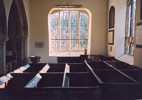 View of the east end of the south View of the east end of the southaisle, showing the box pews |
Seating
Oak box pews with simple fielded panels on sides and backs of the same; brass door catches.
Royal Arms
Shield of George II with extra digit added to read ‘III’. Helm, crest, crown, mantling, supporters, compartment and motto scroll.
Royal Cipher
Coloured wooden plaque above the south door decorated with a crown, St George and the dragon and flowers
| E II R CORONATION. QUEEN ELIZABETH. 2 JUNE 1953 |


